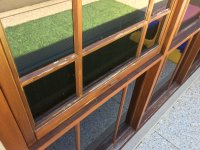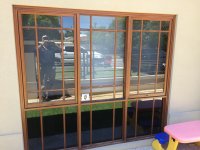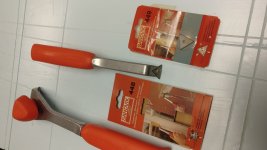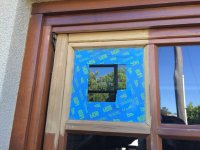I would highly recommend the following hand tool:

If you are unfamiliar, this is the venerable Linbide "General-Purpose" carbide hand scraper. I've had a couple of these (one general purpose and one corner) since the late 90's and I honestly don't know how I'd live or work without them. It may seem hard to believe, but the control that these tools permit (be it removing paint or other finish or removing thin layers of wood in a planing fashion) can come in incredibly handy. They are the first tool I reach for (in advance of a sander, plane, chisel, etc.) whenever I find myself needing to remove something like ahesive, caulk, putty, paint, varnish, poly, epoxy...you name it, these tools excel at the job. The only caveats I would remark on are to be careful around glass and porcelain (since the carbide will scratch glass) and and metals (if you are trying to preserve a finish) plus, if you are located in the U.S., to be mindful of the prohibitions in effect governing lead paint. In the case of the latter, when permitted, I employ a Viper Scraper with with water and dust collection.
A light touch will lead to wonderful results. Remove as little or as much as you wish and blade changes are quick and easy. The tools themselves (and the German-made OEM blades) are widely available from sellers on eBay and Amazon (and elsewhere). A quick google search will provide numerous options.
I recently screened and recoated some hardwood and softwood floors. As part of the prep, I mixed hardwood sawdust with epoxy to fill any areas that had failed since the first time I refinished the same floors (back in the late 1990's using the same technique). To knock off any ridges of hardened epoxy/sawdust I used the Linbide followed by light sanding. In another sreening/recoating project entirely I used the Linbide to remove silicone caulking that had been used to seal quarter-round to a hardwood floor (for energy efficiency purposes). I started out using an putty knife and a utility knife but once I transitioned to the Linbide, I finished four rooms-worth in less time than I'd spent on two walls, if that makes sense. These tools are indispensable in remodeling or historic renovation.
Linbide makes different versions (one for shiplap, others for radii, etc.) which you can learn more about
here.
In your case, I'd use the General Purpose scraper to deftly knock off the failed finish followed by light hand sanding, making sure to protect the glass using painters tape or just a length of paper board in one hand and the scraper (or sand paper/sanding block) in the other. A hand sanding block with integral dust collection (like those made by Mirka) would increase your efficiency - something like
this or the Festool-branded equivalent would be ideal since only plastic would be contacting the glass.
Good luck!







